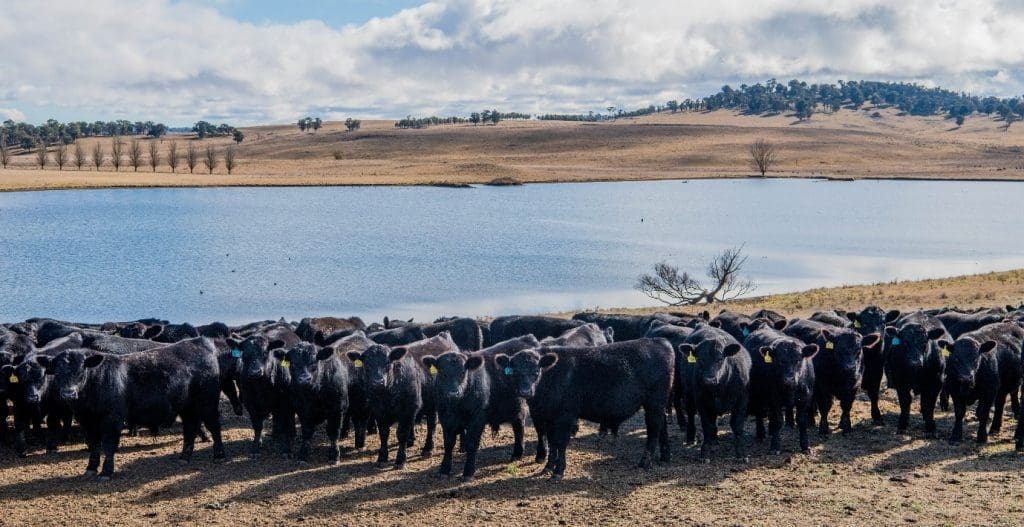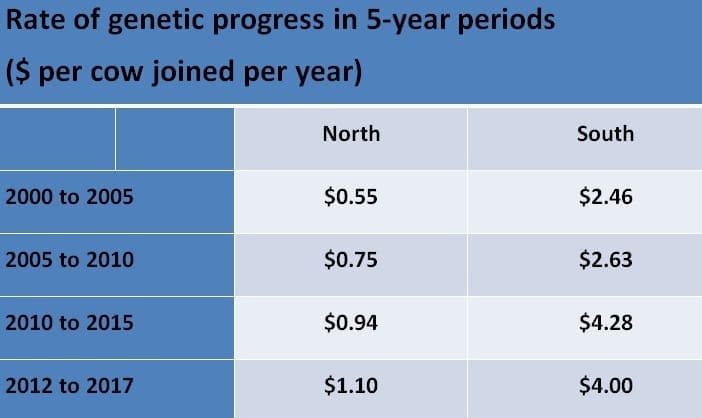WITH so much of the country in the grip of drought and many breeders worrying about how to feed their cows, genetics tends to get pushed into the background.
But if you are running a breeding enterprise, you still need to make genetic decisions.
Director of the Animal Genetics and Breeding Unit, Dr Rob Banks tells us that the good news story is that since the turn of the century, the rate of genetic gain in Australian breeds has doubled.
For the beef industry, this means more dollars in the pocket of not only breeders, but also growers, lotfeeders and processors, as the improvement is in most traits affecting profit along the supply chain.
Breeders benefit from improvements in growth, fertility and calving ease, growers and lotfeeders from extra growth and processors from the higher rates of carcase compliance.
Genetic change is measured as the change in average index value, in dollar units, and indicates an improvement in the profitability of the beef supply chain. The table below shows the rate of genetic change per year in dollar terms.
As shown in the table, the change has been occurring over many years and more impressively, the rate of change has been increasing in both the northern and southern cattle industries.
Dr Banks is confident that the rate can be doubled again through a combination of more focussed selection and use of the new improved genetic evaluation procedures that incorporate genomics.
Most in the beef industry would agree that single trait selection is dangerous as it tends to ignore some of the most important traits.
The most quoted example is selection for weight and its negative effect on calving ease and calf survival. The index system is the best way to balance selection across all traits of importance including traits related to fertility, calving ease, carcase excellence as well as growth.
Role of Indexes
Arguments remain as to what the correct balance of traits is. To get the balance right for each production system and market target, many breed societies have developed a number of indexes. In broad terms, indexes will be reasonably correlated within a breed, reflecting that beef value chain profit comes from fertility, sale of product, and ideally reducing the costs associated with production.
Having worked for many years in the development and promotion of indexes, the author has the firm belief that indexes do indicate more profit, as they address most of the variables that influence profit. They are very simply, technically the best way to optimise genetic improvement for the combination of multiple traits contributing to profit.
The table shows that in the 2000 to 2005 period, genetic progress in the northern breeds was improving profit per cow joined by $0.59 per year (i.e. it was increasing at that rate).
In the five-year period to 2017, the rate of progress was $1.12 per year (i.ee profit per cow was being improved genetically at $1.12 per year).
The values in the table reflect prices and costs at 2010-2012 levels.
NSW seedstock breeder Sam White of Bald Blair Angus has been at the forefront of genetic improvement within the Angus breed for many years, since taking over the family breeding operation from his father. He also runs a large commercial herd alongside his seedstock operation.
When Sam was asked if he thought the genetic change he has seen in the years of breeding was really improvement, he responded with examples of how his 1990 drop cattle performed compared to current day.
“In 1990, Bald Blair were turning steers into the feedlot at 20-24 months of age and only achieving compliance to carcase specs in 50-60pc of them. Today, steers go into the feedlot as young as 12-14 months at similar weight, and are achieving 90pc compliance,” Mr White said.
“These changes have been due to improvement in growth rate and carcase characteristics such as marbling.”

Bald Blair yearling bulls (photo Al Mabin) – genetics despite lack of feed.
Mr White said while genetic change was a big part of this improvement, improved management and nutrition had also been crucial to the improvement.
When selecting bulls for his commercial herd, he uses the Angus Heavy Grain Index, but places a little more emphasis on negative gestation length, as he sees short gestation as allowing him to use ‘a little more-powerful bulls, without causing problems with calving ease’.
Roger Zuill is a commercial breeder with properties at Guyra and Ebor. He chooses the best genetics he can, and uses AI to spread these genetics through his herd.
Asked the same questions as Sam, Mr Zuill said he thought there had been genetic change, and that genetic change was an improvement.
He is keen to push the system further and now tries to choose two Angus sire lines – one for his cow herd and the other as a terminal sire line.
Mr Zuill is also keen to explore improvement in feed efficiency, as he thinks that is going to be more important in the future. Currently most indexes don’t include feed efficiency EBVs.
He is also concerned about mature cow size, which especially in the northern tablelands environment is a significant cost.
“I would like to see more negative emphasis on mature cow weight in the indexes,” Mr Zuill said.

Dion and Hannah Brook
Victorian Shorthorn breeder Dion Brook, of Eloora Shorthorns, Mooralla, agrees that there has been change for the better in Shorthorns, with EBVs allowing him to get better bulls at younger ages.
He thinks indexes do give a balance to selection, but that most bull buyers don’t understand them fully.
“Structure is paramount and non-negotiable, and a degree of class is necessary for stud sires,” Mr Brook said.
Progress in the north
Many reading this article may be alarmed at the relatively slower rate of progress made in the northern-based breeds, compared to those in the south.
Northern breeders have always told us that genetics doesn’t work as well in the north, due to the extensive nature of the industry and the difficulties of recording important traits.
What this means is that it is harder to put into practice – genetics has just as much impact on profit as in the south – there are massive genetic differences for fertility and other profit traits, and breeders are increasingly focussing on them, assisted by valuable R&D such as Dr David Johnston’s Repronomics project.
This and related projects are helping deliver the knowledge and tools to make rapid genetic progress in fertility – overcoming the problem that while the over-riding profit driver in the north is fertility, to date there have been very few accurate fertility EBVs.
Paul Williams of Tropical Beef Technology Services says that the increasing rate of genetic improvement shown is as a result of the steady increase in recording of fertility traits in the northern based breeds.
He said research programs such as ‘Repronomics’ and ‘Northern Genomics’, plus the introduction of the single step BreedPlan analysis meant that the rate of progress will undoubtedly increase in the north. Single step BreedPlan analysis is the most up-to-date method of incorporating DNA marker information into the BreedPlan analysis, in conjunction with the more traditional phenotypic measures.

Tim Emery
Tim Emery, also of TBTS, is just as optimistic as Mr Williams on the future of genetic improvement in the northern based breeds. He says that three breeds – Brahman, Santa Gertrudis and Belmont Red – currently published EBVs for ‘Days to Calving’, and others were working towards it.
He sounded a word of warning, though, about ensuring that phenotypic records continue to be collected going forward.
Having a diverse reference population which have been genotyped and measured for phenotypic records is pivotal for single step BreedPlan. Those producers who are recording phenotypic measurements need to gain recognition and be supported, because without their data, the genetic analysis suffers significantly.
A sustainable beef industry requires improvement in profit for all sectors of the industry.
Improvement in the Breedplan indexes is improving most traits that affect profit, but as the industry has many individual enterprises, the application of indexes will vary and will be used in conjunction with sound management and nutritional programs.
- Guest author, Wayne Upton, is writing our Weekly Genetics Reviews for the next six weeks, while Alex McDonald is on holiday.


I certainly acknowledge the positive contributions of genetic analysis above, however,how long can our industry consider the selection for extreme growth to be a free ride. There are economical and commercial consequences.
The wonderful success of Angus producers comes down to two factors.The widespread importation of US genetics and their dogged pursuit of performance recording. Their cattle are better and they have the numbers to prove it. So how did the US upgrade the traditional small Scottish Aberdeen Angus? By the judicious use of cross breeding followed by unnatural selection ( i.e. line breeding) to fix the problems and give the market a better/new product. Most Angus cattle as a result can now be traced to three sire lines: Precision, New Trend and Band of Ideal.